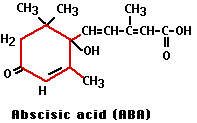
Unlike animals, plants cannot flee from potentially harmful conditions like
They must adapt or die.
The plant hormone abscisic acid (ABA) is the major player in mediating the adaptation of the plant to stress.
Here are a few examples.
ABA mediates the conversion of the apical meristem into a dormant bud. The newly developing leaves growing above the meristem become converted into stiff bud scales that wrap the meristem closely and will protect it from mechanical damage and drying out during the winter.
ABA in the bud also acts to enforce dormancy so if an unseasonably warm spell occurs before winter is over, the buds will not sprout prematurely. Only after a prolonged period of cold or the lengthening days of spring (photoperiodism) will bud dormancy be lifted.
Seeds are not only important agents of reproduction and dispersal, but they are also essential to the survival of annual and biennial plants. These angiosperms die after flowering and seed formation is complete. ABA plays a role in seed maturation, at least in some species, and also enforces a period of seed dormancy. As we saw for buds, it is important the seeds not germinate prematurely during unseasonably mild conditions prior to the onset of winter or a dry season. ABA in the seed enforces this dormancy. Not until the seed has been exposed to a prolonged cold spell and/or sufficient water to support germination is dormancy lifted.
ABA also promotes abscission of leaves and fruits (in contrast to auxin, which inhibits abscission). It is, in fact, this action that gave rise to the name abscisic acid.
The dropping of leaves in the autumn is a vital response to the onset of winter when ground water is frozen - and thus cannot support transpiration - and snow load would threaten to break any branches still in leaf.
| Most nondeciduous species in cold climates (e.g., pines) have "needles" for leaves. These are very narrow and have a heavy waterproof cuticle. The shape aids in shedding snow, and the cuticle cuts down on water loss. |
| Discussion of gas exchange in the leaf. |
ABA is the hormone that triggers closing of the stomata when soil water is insufficient to keep up with transpiration.
The mechanism:| Other plant hormones | ||||
|---|---|---|---|---|
| Auxin | Cytokinins | Ethylene | Gibberellins | |
| Welcome&Next Search |